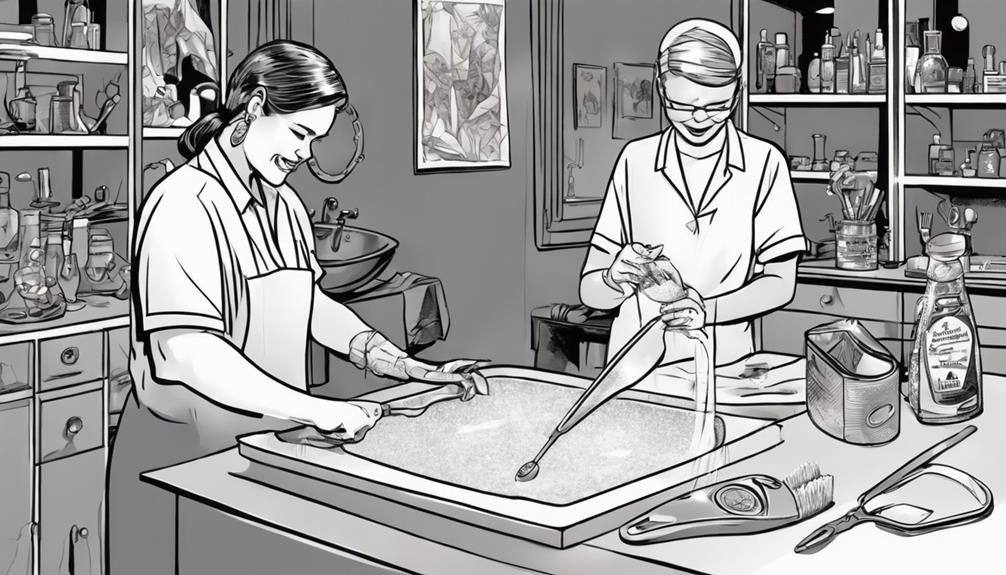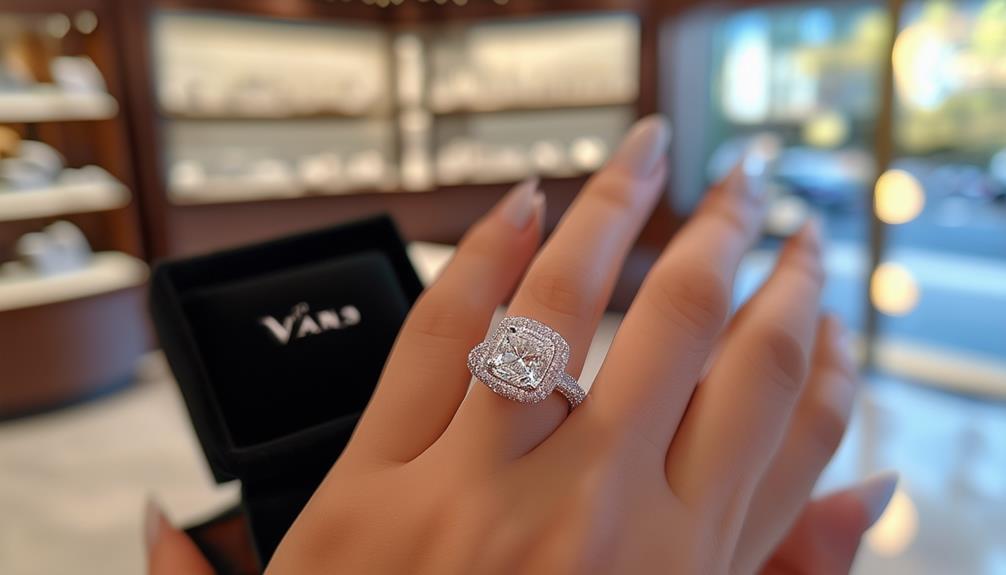Article Contents
Opting for high-quality lab-grown diamond jewellery combines elegance with environmental consciousness. These diamonds, developed using sophisticated methods such as CVD (Chemical Vapour Deposition) and HPHT (High Pressure High Temperature), match the visual and physical characteristics of their natural counterparts, offering exceptional clarity, colour, and size.
This choice not only signifies a dedication to refined taste but also a commitment to ethical practices, promoting conflict-free sourcing and minimising ecological footprint. As ethical consumerism gains momentum, lab-grown diamonds are noted for their transparent production methods and support for fair labour standards.
For individuals who value both luxury and moral responsibility, lab-grown diamonds represent a thoughtful choice that aligns with modern values of sustainable luxury.
Key Points
- Lab-grown diamonds match the exceptional quality, durability, and brilliance of mined diamonds.
- By selecting lab-grown diamonds, you support ethical practices by avoiding conflict diamonds and human rights violations.
- Opting for lab-grown diamonds aids in protecting natural habitats from the destructive impacts of mining.
- Lab-grown diamonds offer clear and transparent sourcing and production processes, adhering to high ethical standards.
- Lab-grown diamonds meet modern demands for luxury and ethical responsibility, thereby building consumer trust.
Defining Lab-Grown Diamonds
Lab-grown diamonds are artificial stones created in controlled lab environments to replicate the properties of natural diamonds. Using advanced techniques like Chemical Vapor Deposition (CVD) and High Pressure High Temperature (HPHT), these diamonds are engineered to have the same chemical composition and structural integrity as those found in nature. As a result, they exhibit comparable durability and visual characteristics, such as brilliance and clarity.
The optical qualities of lab-grown diamonds, including their brilliance, fire, and clarity, are specifically engineered to match those of high-quality mined diamonds. This is achieved by precisely controlling the refractive index and the dispersion of light, which ensures that each stone sparkles intensely and is visually indistinguishable from its natural counterpart.
Opting for lab-grown diamonds supports ethical consumerism, as it bypasses the environmental and ethical issues associated with mining. These diamonds provide a sustainable and ethical alternative without sacrificing the luxury and aesthetic appeal of traditional diamonds, aligning with modern values of responsible consumption and technological advancement.
Ethical Benefits Explored
Exploring the ethical benefits of lab-grown diamond jewellery highlights its role in promoting conflict-free sourcing, which is crucial in today's market.
These diamonds significantly reduce environmental impact and maintain strict ethical standards, improving transparency and fairness within the jewellery industry.
Opting for these sustainable alternatives enables customers to endorse practices that safeguard the environment and respect human rights, thus making a positive contribution to global ethical standards in jewellery production.
Conflict-Free Sourcing
Lab-grown diamonds, which avoid human rights abuses and violent conflicts, ensure ethical sourcing with a traceable and transparent process. These diamonds not only offer peace of mind but also empower consumers to make ethically sound choices.
Each step in the creation of a lab-grown diamond adheres to rigorous ethical standards, promoting fair labour practices and sustainable methods. Choosing lab-grown diamond jewellery supports a market that upholds human dignity and opposes the exploitative conditions often linked to natural diamond extraction.
Thus, these alternatives are not just visually stunning but also align with the principles of ethically conscious consumers.
Reduced Environmental Impact
The production of lab-grown diamonds significantly reduces environmental impact by eliminating the need for harmful mining practices. These diamonds are created in controlled environments that prevent natural habitat destruction and reduce mineral waste, making them a sustainable choice.
Companies like Diamond Foundry are certified carbon-neutral, reflecting their commitment to ethical practices and environmental responsibility. Choosing lab-grown diamonds reduces the demand for mined diamonds and ensures support for ethical sourcing, avoiding the issues associated with the 'blood diamond' industry.
Overview of Production Technology
Lab-grown diamonds are produced using two main methods: Chemical Vapor Deposition (CVD) and High Pressure High Temperature (HPHT). In the CVD method, a diamond seed is placed in a chamber where it is exposed to a carbon-rich gas. This gas is heated, causing carbon atoms to deposit on the seed and gradually form a diamond through the extension of the crystal structure, imitating the natural diamond formation under controlled conditions.
On the other hand, the HPHT method replicates the high-pressure and high-temperature conditions found deep within the Earth. Here, a diamond seed is surrounded by carbon and subjected to intense pressures and temperatures, aiding the transformation of carbon into diamond. This technique recreates the natural diamond-making process of the Earth in a controlled environment.
Both methods produce top-quality diamonds that are sustainable and conflict-free, in line with ethical standards and appealing to consumers who value luxury and responsible sourcing. These techniques demonstrate how advanced technology plays a part in crafting flawless gemstones while upholding ethical practices in the beauty and luxury sectors.
Quality Assessment Criteria
When discussing the quality assessment criteria for lab-grown diamond jewellery, it's important to highlight the comprehensive evaluation process that includes assessments of:
- Cut
- Clarity
- Carat weight
- Colour grade
These criteria are essential for ensuring that each lab-grown diamond replicates the visual and physical characteristics of naturally occurring diamonds.
Expert gemmologists meticulously grade these diamonds to meet stringent industry standards and consumer expectations, thus ensuring trust and consistency in the quality of lab-grown diamonds.
Cut and Clarity Standards
Lab-grown diamonds are assessed using the same rigorous criteria for cut and clarity as natural diamonds. Accuracy in cutting is vital for aligning each facet precisely, enhancing the diamond's capacity to reflect and refract light efficiently.
This method not only enhances the stone's visual appeal but also optimises its brightness and fire, producing a striking visual impact. The careful focus on these elements guarantees that lab-grown diamonds equal the classic charm of natural diamonds, offering a sustainable and opulent choice in high-quality jewellery.
Carat Weight Verification
Carat weight verification is crucial for assessing the quality and value of diamond jewellery, especially for lab-grown diamonds where accurate measurement is critical. This process ensures that each piece conforms to high industry standards, boosting consumer trust.
Meticulous verification not only confirms the precise weight but also supports the authenticity and transparency of the jewellery, thereby enhancing its market value. For consumers, this rigorous adherence to standards allows them to select jewellery that aligns with their aesthetic preferences and ethical values, secure in the knowledge that the quality and carat accuracy are assured.
Colour Grade Evaluation
Colour grading is crucial in evaluating both the beauty and the value of lab-grown diamonds. The colour grade has a significant impact on the visual appeal of the diamond. Diamonds graded in the D to G range are highly valued for their near-colourlessness, similar to the highest-quality natural diamonds.
These grades indicate superior quality and are rare, greatly enhancing the diamond's brilliance by reflecting light effectively. With an understanding of colour grades, buyers can choose diamonds that match their particular aesthetic preferences, enabling them to customise luxury choices to suit their individual tastes.
Comparing Cost and Value
Lab-grown diamonds provide significant cost savings, often up to 70% cheaper than mined diamonds, making them a financially appealing choice. These diamonds are equally beautiful and structurally similar to natural diamonds, ensuring no compromise in quality. For those who view jewellery as a long-term investment, lab-grown diamonds are increasingly attractive, as they are expected to retain their value well and become even more affordable as market trends evolve.
This choice offers both economic benefits and luxury, appealing to those who value financial wisdom without sacrificing aesthetic appeal. As the price gap between lab-grown and mined diamonds continues to narrow, the financial and stylish appeal of lab-grown diamonds grows, making them a preferred option for consumers who prioritise both budget and quality in their jewellery purchases. This evolving market perception underscores lab-grown diamonds as a smart, trustworthy choice in the jewellery market.
Care and Maintenance Tips

Proper care and maintenance are crucial for maintaining the beauty and longevity of your diamond jewellery, whether lab-grown or mined. Regular cleaning with mild soap and warm water is essential to keep your diamonds sparkling. This simple routine empowers you to maintain the brilliance of your jewellery independently.
It is important to avoid harsh chemicals and extreme temperatures, as these can damage the structural integrity of your diamonds. Gentle handling and meticulous care will protect your jewellery from potential damage and expensive repairs. It is advisable to get a professional cleaning and inspection annually to ensure your pieces remain in excellent condition, demonstrating your commitment to quality and self-reliance.
When storing your jewellery, separate each piece to prevent scratches and maintain the unique character of each gem. Proper storage not only protects your jewellery but also reflects your respect for its value and your autonomy in maintaining its pristine condition.
| Care Aspect | Emotion Evoked |
|---|---|
| Regular Cleaning | Empowerment, Brilliance |
| Professional Care | Commitment, Quality |
| Thoughtful Storage | Respect, Autonomy |
Frequently Asked Questions
Why Should You Choose Lab-Grown Diamonds?
Choosing lab-grown diamonds greatly reduces the environmental impact, using cutting-edge technology to provide ethical and sustainable alternatives in luxury. This decision promotes non-violence and environmental conservation, demonstrating a dedication to responsibility and innovation.
Why do people prefer lab-grown diamonds more than diamonds?
Lab-grown diamonds are favoured mainly because of their ethical production and affordability. These diamonds are made in controlled environments, guaranteeing that they are free from the conflicts and environmental damage linked to mining natural diamonds. This feature makes them a responsible and economically practical option for consumers who value both ethical standards and cost-effectiveness.
What Is the Best Grade of Lab-Grown Diamonds?
The highest quality lab-grown diamonds adhere to strict grading standards and are usually certified, demonstrating their quality and authenticity. This makes them a desirable option for consumers seeking ethical and sustainable jewellery choices.
What are the disadvantages of buying lab-grown diamonds?
One significant drawback of purchasing lab-grown diamonds is that they usually have a lower resale value compared to natural diamonds. Furthermore, some individuals may feel a weaker emotional bond with lab-grown diamonds, which can be a crucial factor in diamond purchases that mark special occasions.
Conclusion
Lab-grown diamonds epitomise both ethical progress and technological innovation in jewellery making.
These diamonds, created through sophisticated technology, provide an ethical and affordable option while maintaining the desirable attributes of traditional mined diamonds.
The phrase 'all that glitters is not gold' aptly applies, yet with lab-grown diamonds, the sparkle genuinely reflects a valuable and virtuous choice, deserving attention from informed buyers.

